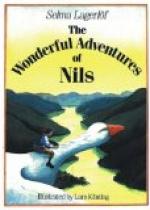The tiny creature walked before them and charmed them along with him, on the road to Vallby. He led them into all sorts of crooks and turns and bends—on through hedges and down into ditches—and wherever he went they had to follow. He blew continuously on his pipe, which appeared to be made from an animal’s horn, although the horn was so small that, in our days, there were no animals from whose foreheads it could have been broken. No one knew, either, who had made it. Flammea, the steeple-owl, had found it in a niche, in Lund cathedral. She had shown it to Bataki, the raven; and they had both figured out that this was the kind of horn that was used in former times by those who wished to gain power over rats and mice. But the raven was Akka’s friend; and it was from him she had learned that Flammea owned a treasure like this. And it was true that the rats could not resist the pipe. The boy walked before them and played as long as the starlight lasted—and all the while they followed him. He played at daybreak; he played at sunrise; and the whole time the entire procession of gray rats followed him, and were enticed farther and farther away from the big grain loft at Glimminge castle.
THE GREAT CRANE DANCE ON KULLABERG
Tuesday, March twenty-ninth.
Although there are many magnificent buildings in Skane, it must be acknowledged that there’s not one among them that has such pretty walls as old Kullaberg.
Kullaberg is low and rather long. It is not by any means a big or imposing mountain. On its broad summit you’ll find woods and grain fields, and one and another heather-heath. Here and there, round heather-knolls and barren cliffs rise up. It is not especially pretty up there. It looks a good deal like all the other upland places in Skane.
He who walks along the path which runs across the middle of the mountain, can’t help feeling a little disappointed. Then he happens, perhaps, to turn away from the path, and wanders off toward the mountain’s sides and looks down over the bluffs; and then, all at once, he will discover so much that is worth seeing, he hardly knows how he’ll find time to take in the whole of it. For it happens that Kullaberg does not stand on the land, with plains and valleys around it, like other mountains; but it has plunged into the sea, as far out as it could get. Not even the tiniest strip of land lies below the mountain to protect it against the breakers; but these reach all the way up to the mountain walls, and can polish and mould them to suit themselves. This is why the walls stand there as richly ornamented as the sea and its helpmeet, the wind, have been able to effect. You’ll find steep ravines that are deeply chiselled in the mountain’s sides; and black crags that have become smooth and shiny under the constant lashing of the winds. There are solitary rock-columns that spring right up out of the water, and dark grottoes




